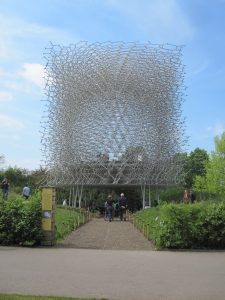All the honey has now been extracted. This year was the first year I noticed such a strong floral smell as I lifted each crown-board. It was possibly the hawthorn which has a strong pungent aroma and is a most erratic yielder. All the honey this year is dark in colour, strong and loth to crystallize. I fear my creamed honey regulars are going to have to get used to clear honey .
One super was simply fitted with eleven starter strips rather than foundation. As the bees drew out this 100% fresh comb, one frame was removed and the remaining ten spaced a little more widely. This gave a slightly wider and heavier comb to cut into blocks. Much of it was also drone comb which, with its larger cells, meant less wax and more honey.
Having removed all the supers I can now complete my records of honey-yield per hive in order to make my decisions as to which queens to over-winter. Eleven colonies and one nucleus are going down to 8 hives. The queen in hive nine was culled and the colony moved around the apiary further than three feet each time placing it alongside other colonies whose number I wanted to boost. Each time it was moved, the flying bees returned to the hive nearest its old position. This way I gradually bled half the colony into other hives. The remainder was then united in its full-sized box with the nucleus colony. Each frame of bees was gently misted with a dilute sugar solution with a drop of oil of lavender to mask the colony aromas and the frames placed alternately into the 14 x 12 box and left for a few days to settle down. This box was then united with hive 1 using the newspaper method. The queen was removed from colony 1 and then later in the evening, this queenless colony was placed above the queen-right colony with a sheet of paper between them. By the time they had nibbled through, their aromas were sufficiently blended as to avoid any confrontation.
The varroa counts have reached scary levels so I decided to treat with Apivar before I feed. Having had Deformed Wing Virus and Chronic Bee Paralysis Virus during the year I thought it best not to just leave it to the beegyms. The hives fitted with beegyms have registered noticeably higher mite-falls but the beegym instructions do say ‘use as part of your integrated pest management’.
Next week we have the ‘Taster Session’ for prospective beekeepers followed by Audley End Apple Weekend. Lots of hard work to finish the season.



